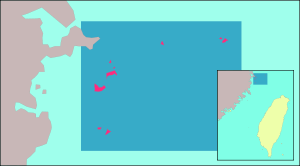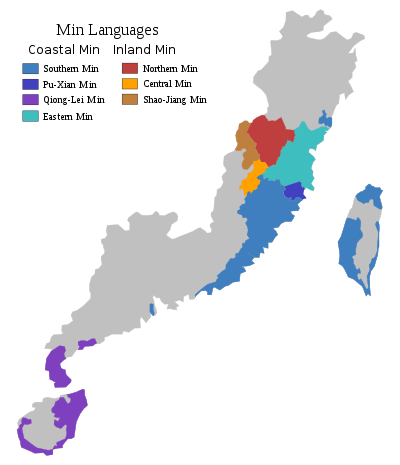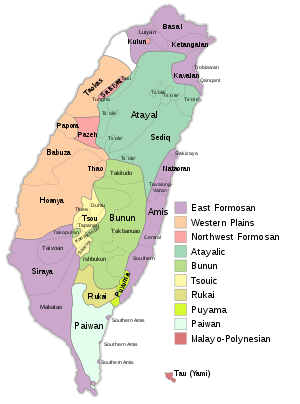Matsu dialect
| Matsu dialect | |
|---|---|
|
馬祖話 / Mā-cū-huâ 平話 / Bàng-huâ | |
| Pronunciation | [mɑ˧˩ tsu˥˥ uɑ˩˧˩] / [paŋ˧˩ ŋuɑ˩˧˩] |
| Native to | Republic of China |
| Region | Matsu Islands |
| Ethnicity | Fuzhounese |
|
Sino-Tibetan
| |
| Chinese characters and Foochow Romanized | |
| Official status | |
Official language in | none |
Recognised minority language in |
one of the statutory languages for public transport announcements in the Matsu Islands, Republic of China[1] |
| Language codes | |
| ISO 639-3 | – |
| Glottolog | None |
| Linguasphere |
79-AAA-ico |
 Location of Matsu Islands | |
Matsu dialect (Eastern Min: Mā-cū-huâ / 馬祖話) is the local dialect of Matsu Islands, Republic of China. Native speakers also call it Bàng-huâ (平話), meaning the language spoken in everyday life. It is recognised one of the statutory languages for public transport announcements in Lienchiang County, ROC.[1]
It is a subdialect of Fuzhou dialect, Eastern Min. Matsu dialect is quite similar to Changle dialect, another subdialect of Fuzhou dialect.
Phonology
Matsu dialect has 17 initials, 46 rimes and 7 tones.
Initials
| Bilabial | Alveolar | Velar | Glottal | ||
|---|---|---|---|---|---|
| Nasal | /m/ (蒙) | /n/ (日) | /ŋ/ (語) | ||
| Plosive | aspiration | /pʰ/ (波) | /tʰ/ (他) | /kʰ/ (氣) | |
| plain | /p/ (邊) | /t/ (低) | /k/ (求) | /ʔ/ (鶯) | |
| Fricative | /s/ (時) | /h/ (喜) | |||
| Affricate | aspiration | /tsʰ/ (出) | |||
| plain | /ts/ (曾) | ||||
| Lateral | /l/ (柳) | ||||
Rimes
There are 46 rimes in Matsu dialect.
| monophthong | compound vowel | nasal coda /-ŋ/ | checked coda /-ʔ/ |
|---|---|---|---|
| [a/ɑ](蝦/罷) | [ia/iɑ](寫/夜) | [aŋ/ɑŋ](三/汗) | [aʔ/ɑʔ](盒/鴨) |
| [ɛ/a](街/細) | [ie/iɛ](雞/毅) | [iŋ/ɛiŋ](人/任) | [øʔ/œʔ](扔/嗝) |
| [œ/ɔ](驢/告) | [iu/ieu](秋/笑) | [uŋ/ouŋ](春/鳳) | [eʔ/ɛʔ](漬/咩) |
| [o/ɔ](哥/抱) | [ua/uɑ](花/話) | [yŋ/øyŋ](銀/頌) | [oʔ/ɔʔ](樂/閣) |
| [i/ɛi](喜/氣) | [uo/uɔ](科/課) | [iaŋ/iɑŋ](驚/命) | [iʔ/ɛiʔ](力/乙) |
| [u/ou](苦/怒) | [yo/yɔ](橋/銳) | [ieŋ/iɛŋ](天/見) | [uʔ/ouʔ](勿/福) |
| [y/øy](豬/箸) | [ai/ɑi](紙/再) | [uaŋ/uɑŋ](歡/換) | [yʔ/øyʔ](肉/竹) |
| [au/ɑu](郊/校) | [uoŋ/uɔŋ](王/象) | [iaʔ/iɑʔ](擲/察) | |
| [ɛu/ɑu](溝/構) | [yoŋ/yɔŋ](鄉/樣) | [ieʔ/iɛʔ](熱/鐵) | |
| [øy/ɔy](催/罪) | [ɛiŋ/aiŋ](恒/硬) | [uaʔ/uɑʔ](活/法) | |
| [uai/uɑi](我/怪) | [ouŋ/ɔuŋ](湯/寸) | [uoʔ/uɔʔ](月/郭) | |
| [ui/uoi](杯/歲) | [øyŋ/ɔyŋ](桶/洞) | [yoʔ/yɔʔ](藥/弱) | |
| [ɛiʔ/aiʔ](賊/黑) | |||
| [ouʔ/ɔuʔ](學/骨) | |||
| [øyʔ/ɔyʔ](讀/角) | |||
Many rimes come in pairs: in the table above, the one to the left represents a close rime (緊韻), while the other represents an open rime (鬆韻). The close/open rimes are closely related with the tones (see below).
Tone
| No. | 1 | 2 | 3 | 4 | 5 | 6 | 7 |
|---|---|---|---|---|---|---|---|
| Tone name | dark level 陰平 |
light level 陽平 |
rising 上聲 |
dark departing 陰去 |
light departing 陽去 |
dark entering 陰入 |
light entering 陽入 |
| rime type | close rime | close rime | close rime | open rime | open rime | open rime | close rime |
| Tone contour | 55 ˥˥ | 51 ˥˩ | 33 ˧˧ | 312 ˧˩˨ | 131 ˩˧˩ | 13 ˩˧ | 5 ˥ |
| Example Hanzi | 君 /kuŋ˥˥/ |
臺 /tai˥˩/ |
祖 /tsu˧˧/ |
去 /kʰɔ˧˩˨/ |
話 /uɑ˩˧˩/ |
福 /houk̚˩˧/ |
掘 /kuk̚˥/ |
The relationship between tone and rime
In Matsu dialect, level tone (平聲), rising tone (上聲) and light entering (陽入) should read in close rimes (緊韻); departing tone and dark entering should read in open rimes (鬆韻).
For example, "a̤" have two pronunciations, /ɛ/ in close rime and /a/ in open rime; "a̤h" have two pronunciations, /eʔ/ in close rime and /ɛʔ/ in open rime. so we get the table:
| Tone name | dark level | light level | rising | dark departing | light departing | dark entering | light entering |
|---|---|---|---|---|---|---|---|
| Tone contour | 55 ˥˥ | 51 ˥˩ | 33 ˧˧ | 312 ˧˩˨ | 131 ˩˧˩ | 13 ˩˧ | 5 ˥ |
| Rime type | close rime | close rime | close rime | open rime | open rime | open rime | close rime |
| Foochow Romanized | ă̤ | à̤ | ā̤ | á̤ | â̤ | á̤h | ă̤h |
| Pronunciation | ɛ˥˥ | ɛ˥˩ | ɛ˧˧ | a˧˩˨ | a˩˧˩ | ɛʔ˩˧ | eʔ˥ |
Close rime tone "ă̤" should be pronounced as /ɛ˥˥/ instead of /a˥˥/; and open rime tone "â̤" should be pronounced as /a˩˧˩/ instead of /ɛ˩˧˩/.
Sandhi and assimilation
Tone sandhi
Matsu dialect has extremely extensive tone sandhi rules: in an utterance, only the last syllable pronounced is not affected by the rules. The two-syllable tonal sandhi rules are shown in the table below (the rows give the first syllable's original citation tone, while the columns give the citation tone of the second syllable):
| dark level 55 |
light level 51 |
light entering 5 |
rising 33 |
dark departing 312 |
light departing 131 |
dark entering 13 | |
| dark level 55 |
|||||||
| dark departing 312 |
|||||||
| light departing 131 |
|||||||
| dark entering B 13 |
|||||||
| rising 33 |
half dark departing (31) | 13 (dark entering lost its entering coda) |
dark level (55) | ||||
| dark entering A 13 |
31 + /-ʔ/ (half dark departing added a entering coda "/-ʔ/") |
dark entering (13) | light entering (5) | ||||
| light level 51 |
rising (33) | half dark departing (31) | rising (33) | half dark departing (31) | |||
| light entering 5 |
rising (33) or rising + /-ʔ/ |
light level (51), or light entering (5) | |||||
In the table above, "dark entering A" means dark entering coda ended with /-k̚/, "dark entering B" means ended with /-ʔ/. In mordern spoken language, it's hard to distinguish with each other in individual syllable, but we can find their differences in tone sandhi.
Like Fuzhou dialect, the tonal sandhi rules of more than two syllables display further complexities.
Perseverative assimilation
The two-syllable initial assimilation rules are shown in the table below:
| The Coda of the Former Syllable | The Initial Assimilation of the Latter Syllable |
|---|---|
| Null coda |
|
| Nasal coda /-ŋ/ |
|
| entering coda (/-ʔ/, /-k̚/) | remain unchanged. |
Anticipatory assimilation
In Matsu dialect, if rime type of the former syllable is changed while tone sandhi occurred, the rime of the former syllable should be changed to adapt the rule of close/open rimes.
For example, "技" /kɛi˧˩˨/ is a syllable which has dark departing tone, it's an open rime; "師" /sy˥˥/ has a dark level tone. When combined together as the phrase "技師" (technician), "技" changes its tonal value to rising tone. Rising tone is a close rime tone, therefore the pronunciation as a whole is /ki˧˧ ly˥˥/.
References
Further reading
External links
- (in traditional Chinese) Fuzhou Dialect Textbook: Elementary school textbook in Matsu.
- (in traditional Chinese)Fast learning
- (in simplified Chinese)The difference of common vocabulary between Matsu dialect and Fuzhou dialect

